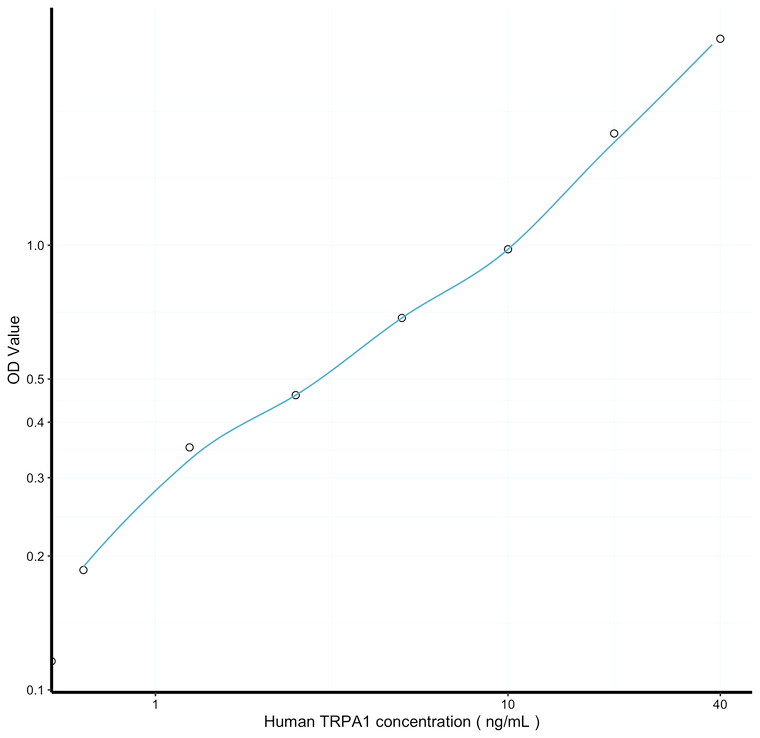| Applications: |
ELISA |
| Reactivity: |
Human |
| Note: |
STRICTLY FOR FURTHER SCIENTIFIC RESEARCH USE ONLY (RUO). MUST NOT TO BE USED IN DIAGNOSTIC OR THERAPEUTIC APPLICATIONS. |
| Sensitivity: |
0.214ng/mL |
| Detection Limit: |
0.625-40ng/mL |
| Short Description: |
This TRPA1 Sandwich ELISA Kit is an in-vitro enzyme-linked immunosorbent assay for the measurement of samples in human cell culture supernatant, serum and plasma (EDTA, citrate, heparin). |
| Storage Instruction: |
Store the unopened kit in the fridge at 2-8°C for up to 6 months. Once opened store individual kit contents according to components table provided with the kit. |
| Assay Time: |
4.5 hrs |
| Gene Symbol: |
TRPA1 |
| Gene ID: |
8989 |
| Uniprot ID: |
TRPA1_HUMAN |
| Sample Type: |
tissue homogenates, cell lysates or other biological fluids. |
| Tissue Specificity | Expressed at very low levels in fibroblasts. |
| Post Translational Modifications | TRPA1 activation by electrophiles occurs though covalent modification of specific cysteine residues in the N-terminal cytoplasmic domain. Hydroxylation is required for TRPA1 activity inhibition in normoxia. In hypoxia, the decrease in oxygen concentration diminishes the activity of the hydroxylase EGLN1, thus relieving TRPA1 from inhibition and ultimately leading to channel activation. Oxidation of Cys-633 and Cys-856 in hyperoxia may override the hydroxylase EGLN1-mediated inhibition, causing TRPA1 activation. |
| Function | Receptor-activated non-selective cation channel involved in pain detection and possibly also in cold perception, oxygen concentration perception, cough, itch, and inner ear function. Shows 8-fold preference for divalent over monovalent cations. Has a central role in the pain response to endogenous inflammatory mediators and to a diverse array of irritants, such as allylthiocyanate (AITC) from mustard oil or wasabi, cinnamaldehyde, diallyl disulfide (DADS) from garlic, and acrolein, an irritant from tears gas and vehicle exhaust fumes. Acts also as an ionotropic cannabinoid receptor by being activated by delta(9)-tetrahydrocannabinol (THC), the psychoactive component of marijuana. Is activated by a large variety of structurally unrelated electrophilic and non-electrophilic chemical compounds. Electrophilic ligands activate TRPA1 by interacting with critical N-terminal Cys residues in a covalent manner, whereas mechanisms of non-electrophilic ligands are not well determined. May be a component for the mechanosensitive transduction channel of hair cells in inner ear, thereby participating in the perception of sounds. Probably operated by a phosphatidylinositol second messenger system. |
| Protein Name | Transient Receptor Potential Cation Channel Subfamily A Member 1Ankyrin-Like With Transmembrane Domains Protein 1Transformation-Sensitive Protein P120P120Wasabi Receptor |
| Database Links | Reactome: R-HSA-3295583 |
| Cellular Localisation | Cell MembraneMulti-Pass Membrane Protein |
| Alternative ELISA Names | Transient Receptor Potential Cation Channel Subfamily A Member 1 ELISA kitAnkyrin-Like With Transmembrane Domains Protein 1 ELISA kitTransformation-Sensitive Protein P120 ELISA kitP120 ELISA kitWasabi Receptor ELISA kitTRPA1 ELISA kitANKTM1 ELISA kit |
| output | |
Information sourced from Uniprot.org
12 months for antibodies. 6 months for ELISA Kits. Please see website T&Cs for further guidance







